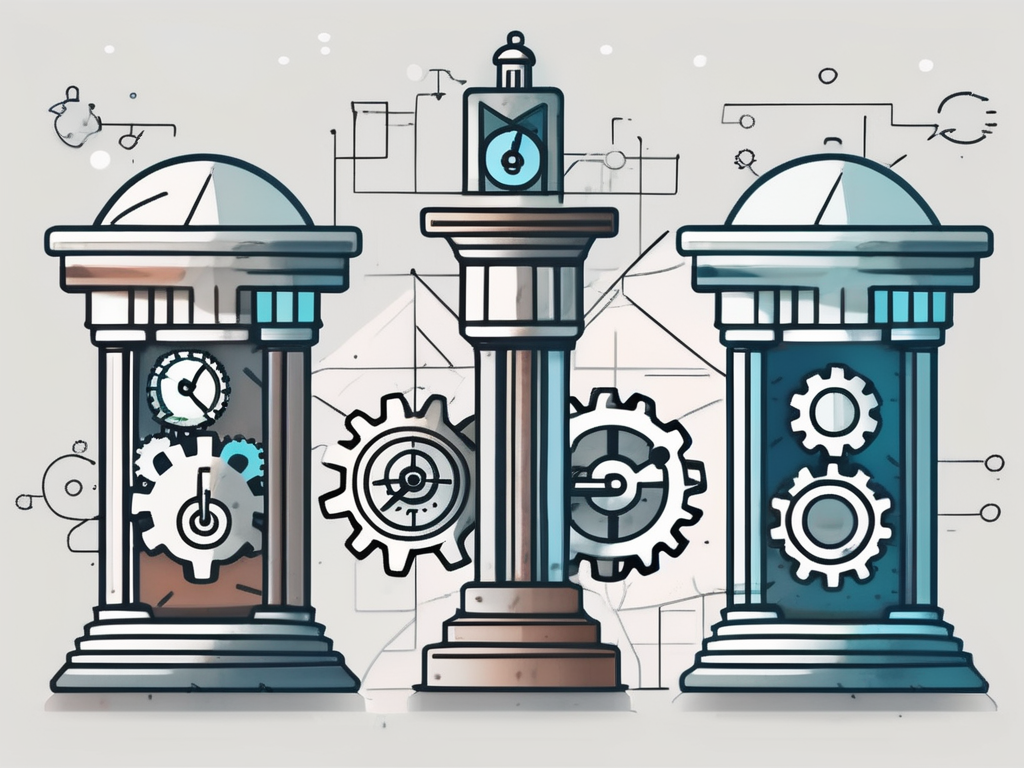
Comparing Roadmap, Timeline, and Deadline: Which is the Best Project Management Approach?

Project management is a crucial aspect of any successful endeavor. Whether you are planning a small personal project or tackling a large-scale business initiative, having a well-defined approach is essential.
In this article, we will explore three commonly used project management approaches: roadmap, timeline, and deadline methods. By understanding the features, benefits, and limitations of each approach, you can make an informed decision about which one suits your project the best.
{{resources-component-1}}
Understanding the Basics of Project Management
Before we delve into the specifics of each approach, let's first define what a roadmap, timeline, and deadline are in the context of project management.
Defining Roadmap, Timeline, and Deadline
A roadmap is a visual representation of the project's objectives, tasks, and milestones. It provides a high-level overview of the project's strategic direction and serves as a guide for decision-making. A well-designed roadmap not only outlines the project's goals but also highlights the key steps and dependencies required to achieve them. It acts as a compass, ensuring that everyone involved in the project understands the overall vision and how their individual tasks contribute to the bigger picture.
A timeline, on the other hand, is a chronological sequence of events or activities that need to be completed within a specific timeframe. It outlines the project's schedule and helps in tracking progress. By breaking down the project into smaller, manageable tasks and assigning them specific timeframes, a timeline provides a clear roadmap for execution. It allows project managers to monitor the progress of each task, identify potential bottlenecks, and make necessary adjustments to ensure timely completion.
Lastly, a deadline is a fixed point in time by which a particular task or goal must be achieved. Deadlines play a crucial role in project management as they create a sense of urgency and accountability. By setting realistic and achievable deadlines, project managers can motivate team members to stay focused and deliver their work on time. Deadlines also help in prioritizing tasks and allocating resources effectively, ensuring that the project stays on track and meets its objectives within the desired timeframe.
The Importance of Project Management Approaches
Effective project management approaches are vital for several reasons. They provide structure and clarity, helping teams navigate through complex projects with ease. By defining clear objectives, outlining tasks, and establishing milestones, project management approaches ensure that everyone involved understands their roles and responsibilities, reducing confusion and promoting a unified vision.
Furthermore, project management approaches help in setting realistic goals and expectations. By breaking down the project into smaller, achievable tasks, teams can better estimate the time, effort, and resources required for successful completion. This prevents overcommitment and ensures that projects are completed within the allocated budget and timeframe.
In addition, project management approaches facilitate communication and collaboration among team members. By establishing clear channels of communication, project managers can foster a collaborative environment where ideas are shared, feedback is given, and issues are addressed promptly. Effective communication ensures that everyone is on the same page, minimizing misunderstandings and promoting a harmonious working relationship.
Lastly, project management approaches enable efficient resource allocation. By carefully planning and organizing tasks, project managers can allocate resources effectively, ensuring that each team member has the necessary tools, skills, and support to complete their assigned tasks. This prevents resource wastage and maximizes productivity, ultimately leading to successful project outcomes.
By choosing the right project management approach, you can optimize the project's chances of success. Each project is unique, and different approaches may be more suitable depending on factors such as project size, complexity, and team dynamics. Understanding the basics of project management, including roadmaps, timelines, and deadlines, is essential for any project manager looking to deliver successful projects.
Deep Dive into the Roadmap Approach
Now that we have a basic understanding of project management, let's explore the roadmap approach in more detail.
The roadmap approach is a strategic planning tool that provides a visual representation of the project's goals, milestones, and timelines. It serves as a guide for project managers and stakeholders, outlining the overall direction and strategic objectives. By breaking down a complex project into manageable phases, the roadmap ensures that goals are achieved step by step.
Benefits of Using a Roadmap
The roadmap approach offers several advantages. Firstly, it provides a big-picture view of the project, allowing stakeholders to understand the overall direction and strategic objectives. This holistic perspective helps in prioritizing tasks and allocating resources effectively.
Moreover, a roadmap encourages collaboration and transparency among team members. By visualizing the project's timeline and milestones, everyone can see how their contributions fit into the larger project. This fosters a sense of ownership and accountability, as individuals understand the impact of their work on the project's success.
Potential Drawbacks of the Roadmap Approach
While the roadmap approach has its benefits, it also comes with a few limitations. Firstly, it may lack granular detail, making it difficult to track progress on a day-to-day basis. While the roadmap provides a high-level overview, it may not capture the intricacies and nuances of individual tasks and deadlines. Project managers need to supplement the roadmap with other tools, such as task management software, to ensure effective tracking and monitoring of progress.
Additionally, roadmaps can be inflexible and may need frequent adjustments as the project evolves. Changes in requirements, priorities, or external factors can impact the accuracy and relevance of the roadmap. It is important for project managers to regularly review and update the roadmap to ensure it aligns with the project's evolving needs.
Furthermore, roadmaps often rely heavily on assumptions about the project's scope, resources, and constraints. These assumptions may not always hold true, leading to deviations from the original roadmap. Project managers need to be flexible and adaptive, ready to make necessary adjustments to the roadmap as new information becomes available.
In conclusion, the roadmap approach is a valuable tool for project management, providing a high-level overview of the project's goals and milestones. It helps in prioritizing tasks, allocating resources, and fostering collaboration among team members. However, project managers need to be aware of the limitations of the roadmap approach and supplement it with other tools and techniques to ensure effective project execution.
Exploring the Timeline Method
Next, let's turn our attention to the timeline approach, which focuses on setting deadlines for individual tasks or milestones.
Advantages of the Timeline Approach
The timeline approach offers several benefits. Firstly, it provides a clear visual representation of the project's schedule and helps in managing time effectively. It enables stakeholders to track progress in real-time and identify any delays or bottlenecks. Additionally, timelines enhance accountability, as individuals are aware of their deadlines and are more likely to work towards meeting them. Lastly, timelines make it easier to communicate project progress with stakeholders and demonstrate the project's milestones achieved.
Limitations of Using Timelines
Despite its advantages, the timeline approach also has its share of limitations. Firstly, setting rigid deadlines can create unnecessary pressure and lead to compromised quality. It may be challenging to accurately estimate the time required for each task, especially for complex projects. Moreover, timelines may not account for unexpected delays or dependencies, which can disrupt the project's overall schedule. Adapting to changes becomes difficult when timelines are too rigid, so maintaining flexibility is crucial.
The Deadline-Driven Approach
Lastly, let's explore the deadline-driven approach, which places significant emphasis on meeting fixed deadlines.
Pros of a Deadline-Based Approach
A deadline-driven approach offers a few advantages. Firstly, it instills a sense of urgency and ensures that tasks are completed within a specified timeframe. Deadlines are a powerful motivator that can enhance productivity and focus. Additionally, meeting deadlines can build trust and credibility, both internally and externally. Clients or stakeholders often have their own deadlines, and aligning with their expectations can lead to stronger relationships.
Cons of Relying on Deadlines
While the deadline-driven approach has its benefits, it also comes with a few drawbacks. Firstly, prioritizing deadlines above all else can lead to shortcuts and compromises on quality. Rushed work often leads to errors and rework, which can negatively impact the project's outcome. Moreover, relying solely on deadlines may not consider the complexity of certain tasks or allow sufficient time for iteration and improvement. Striking a balance between timeliness and quality is crucial when using this approach.
Choosing the Right Approach for Your Project
Now that we have explored the features and considerations of each project management approach, let's discuss how to select the right one for your specific project.
Factors to Consider When Selecting an Approach
Several factors can influence your approach selection. Firstly, consider the nature and complexity of your project. Some projects may benefit from a roadmap approach, particularly those with multiple phases and dependencies. On the other hand, simpler projects may require a more straightforward timeline or deadline approach. Assess the available resources, team dynamics, and external constraints to determine the best fit. Additionally, consider the project's level of flexibility and the desired level of stakeholder engagement. All these factors play a crucial role in selecting the most appropriate approach.
Tailoring Your Approach to Your Project's Needs
Remember, project management is not a one-size-fits-all solution. It is important to tailor the selected approach to your project's unique needs. Customize templates, tools, and methodologies to align with your project's objectives and constraints. Regularly evaluate and adjust your approach to accommodate changes and ensure ongoing success.
In conclusion, the choice between roadmap, timeline, and deadline approaches depends on the specific needs and characteristics of your project. Each approach has its own set of advantages and limitations, and it is crucial to understand them to make an informed decision. By considering factors such as project complexity, resource availability, stakeholder engagement, and desired flexibility, you can choose the most appropriate project management approach. Remember to continually review and adapt your approach as your project evolves to optimize its chances of success.















